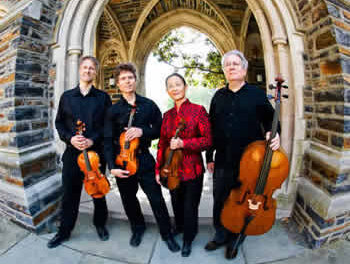The North Carolina Symphony‘s most recent concert in Raleigh left me with a clear first impression of the ensemble’s artistic goals. Playing well within their wheelhouse, the NCS both ventured into contemporary work and honored the time-tested classics.
Looking at this season’s programming, it’s clear that the NCS has serious stake in performing the classics. Expectedly, I gathered that their audiences are also accustomed to these masterworks. Considering that reputation, programming Caroline Shaw‘s “Entr’acte” (2011) was an adventurous choice! Addressing the audience before the Shaw, guest conductor Douglas Boyd observed that audiences tend to sink into their seats when presented with new music. Although I think his advice of “fear not” implies a generally sour attitude towards contemporary music, I wholeheartedly agree with Boyd that Shaw’s music is often written in a style that is inviting and accessible to even the most apprehensive listeners. Even though Shaw herself is less interested in the categorization of her music, I think one way to describe her compositional style is “classical adjacent.” It’s derived and inspired by classical language but totally unafraid of embracing new sounds, textures, and techniques. For all these reasons, I was particularly interested in how the ensemble’s spin on Shaw would compare to Tchaikovsky and Sibelius.
Beginning in mostly familiar territory, the piece recalls the Haydn string quartet that inspired Shaw to write the piece. However, it doesn’t take long for Shaw to wander from the beaten path. After exploring surprising dissonances and jaunty harmonics, the orchestra arrived at a delightful frolic. Punctuated with Bartokian pizzicato, episodes of “pitchless bow-noise,” and always returning to a light bounciness, the quietly happy work ends like a lost balloon spiraling skyward. In an effervescent unraveling, the ensemble made way for principal cellist Bonnie Thron‘s unaccompanied solo. A simple, strummed solo that relies just as much on silence as it does on notes, Thron found opportunity in the sparse scoring to tell the audience a little about her own relationship with Shaw’s music. In the moment, I felt as though I could see the topography of her fingertips as they gently brushed past each string. Just outside of their comfort zone, I think the NCS found great vulnerability and versatility with the help of Shaw’s music.
Conversely, the NCS boasted the foundations of their musical strength through Sibelius’ Symphony No. 2 in D. With their steadfast pacing, the slow-burning suspense culminated in an especially triumphant and indomitable conclusion with the final movement. After the opening work from the strings and a violin-heavy concerto, the orchestra’s wind players ushered in a previously unheard vastness and gravity. Section playing from woodwinds, brass, and low strings was paramount to realizing the hugeness of the piece. Surprisingly, I felt some similarities between the Sibelius and Shaw. Sibelius’ work rejects many of the standard conventions of the symphony’s sonata form and instead relies on simple motivic development. And while Symphony No. 2 is still a major part of the regular canon, pairing it with the Shaw gave the NCS an opportunity to accentuate some of its uniqueness.
Although it was the featured piece, Tchaikovsky’s Violin Concerto in D felt like the odd ball out from the evening’s program. Overflowing with rambling melodic material, the concerto (sitting at a whopping 35 minutes) felt excessive. Soloist Chee-Yun was technically phenomenal and possessed all the virtuosity and stamina demanded by such a behemoth concerto. But compared to the Sibelius, which revealed the strengths of the ensemble as a community, and the Shaw, which demonstrated their willingness to grow and embrace new challenges, I’m not sure if the Tchaikovsky had anything important to say about the musicians on stage. Mendelssohn, Vieuxtemps, and even Sibelius wrote violin concerti that I feel could have contributed more personality to the concert. This Tchaikovsky concerto saw the NC Symphony execute a marvel of violin writing, no doubt, but did it offer anything more than flashiness?
The North Carolina Symphony clearly knows where their strengths lie. But they’re also aware of where their programming has room to grow, and they’re willing to take risks as part of that process.











